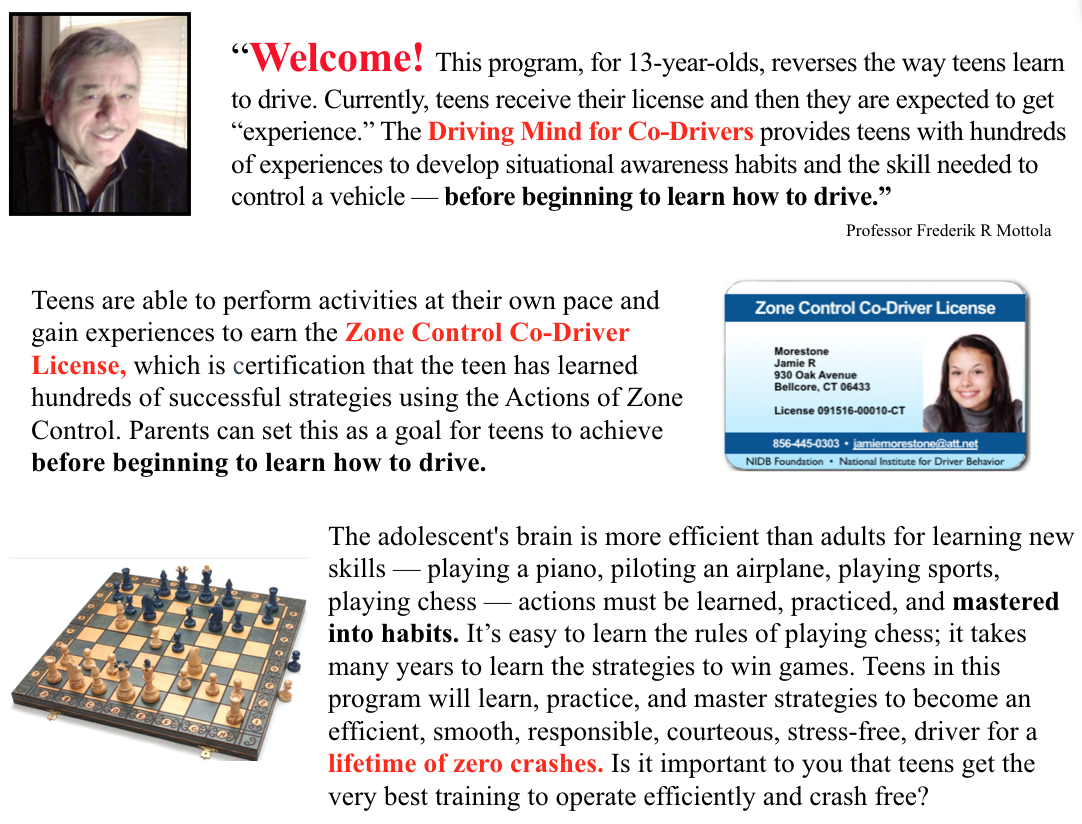Everyone knows of friends and relatives who have been in car crashes. Crashes occur so frequently that they are accepted –– in some cases expected to happen. There is a flood of information stating that teen drivers have a higher percentage of crashes than mature “experienced” drivers. It doesn’t have to be this way! Teen drivers should be better drivers than their parents and better than the majority of “experienced” drivers. The only things preventing teens from becoming “expert” drivers are the low expectations that society places upon them and the failure of our driver licensing system to place higher standards upon our educational system to provide teens with more than basic driver education.
Basic driver education is able to teach the conscious level of driving –– the rules of the road, how to use the vehicle’s controls, and necessary skills and information to pass the licensing exam. However, basic driver education isn’t able to develop and evaluate the unconscious values that already live in the teen’s unconscious mind. Applying John Locke’s conception of the mind, teens do not come into the driver education course with a completely blank slate; the many experiences they have had over their 15-16 years are indelible and often invisible to the teen, the teacher and parents. In the short time span in which novice driver education programs are conducted, there is neither time, nor opportunity, to evaluate how these experiences have been steeped into habits – unconscious values – for space management, or mismanagement.
It is the unconscious habits that dictate the position and speed vehicles travel in all situations. It’s the “feeling” of comfort a driver is able to accept for the approaching situation. Two drivers approach the same red traffic light: Driver 1 sees the light 15 seconds ahead, takes her foot off the gas, checks her rearview mirror, makes a slight braking action, and arrives five seconds away from the intersection when the light changes to green, searches the intersection to the left, front, and right for a clear path, continues through while gradually increasing speed back to 45-miles-per-hour –– a demonstration of expert space management. Driver 2, while 15 seconds away, continues to accelerate, applies a forceful braking action, bounces the car to a stop, waits impatiently for the light to change, and accelerates forcefully ahead at the first gleam of the green light only to speed ahead to the next red light where the same chain of actions will be repeated, repeated, repeated. Sooner, or later, perhaps on the 3,556th repeat of emulating a drag racer’s reaction to the yellow light, there is a pedestrian, or motorcyclist, or an aggressive SUV driver attempting to cross the intersection at the end of the yellow light. Just like that, during that one critical second, the “dragster” loses the race and lives are lost.
Both drivers performed all of their actions by habit without any conscious awareness. Their minds could have been on thoughts far away. Their actions, a second before the crash, were completely comfortable and acceptable to them. There were no thoughts of “right” or “wrong,” no feelings of “safety” or “danger” –– they were merely “driving.” Stand on any busy traffic light controlled intersection to see Driver 2 and all of his friends who follow him blindly, unknowingly, unaware of better choices that could be made. While standing on that corner you may have difficulty finding a driver performing the behaviors of Driver 1, the one who knows how to effectively manage space.
Isn’t it time families demand essential training and effective driver licensing exams to help teens acquire the space management habits necessary to stay out of crashes?
Go to this link for free “Driver Wellness Training” Driver Wellness Training-2 Use Guess Access.
About the author: Frederik Mottola, Professor Emeritus at Southern Connecticut State University and Executive Director of the National Institute for Driver Behavior, has, for the past 54 years, researched and developed techniques to help drivers learn good habits for space-management. A scientist, inventor, educator, and author, he has designed successful crash-reducing programs for corporations, municipalities, police, military, emergency vehicle operators, and traffic safety educators on national and international levels.


